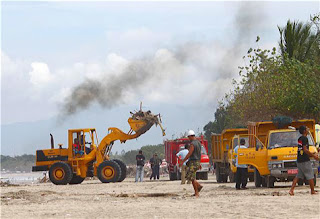RESULTS:
After researching satellite images using observation and comparing data we were able to back up our hypothesis by showing that the locations with the greatest amount of human population and the developed areas of Southern Bali are in fact point sources of pollution. We located resort areas that are known for tourism and concurring waste by examining aerial images of Bali. The increasingly developed areas are easily identifiable, as well as the rivers flowing through and along the populated regions. We conclude that the waste accumulated in the cities is washed onto the beaches either by entering the river systems and/or being washed up by wet season run-off. The pollution is affecting the natural habitat that Bali is praised for, reiterating that this is a pressing issue that demands a solution. These photos were taken at Kuta Beach after heavy rain during the wet season. The rains flush all the pollution from Kuta's streets on to the beach, leaving a mess so big tractors, bulldozers and the help of many hands are needed to clear the beach of all the debris.
DISCUSSION:
Through our research we have discovered that it is very difficult to study pollution using satellite imagery. Despite the fact Bali’s polluted beaches are unmistakable eyesores in person, garbage, litter and pollution are not easily visible from space. Learning early on that this project would be challenging, we tailored our research goals to focus on things we knew we could study from space, using satellites. Bali’s rivers are indeed transporters of pollution. However, a better indicator of pollution is population. The more populated and popular an area is the more pollution occurs. The most developed tourist destinations and the most densely populated cities are the most polluted and biggest contributors to Bali’s pollution crisis.
Where we found the satellite images to be the most helpful and informative was in identifying where exactly the watersheds emptied into the Indian Ocean as well as targeting the most developed areas of Bali. With the DMSP satellite image, the night-lights clearly show where the majority of Bali’s population resides. The Landsat satellites make it possible to view our study area in ways we are incapable of seeing with the naked eye. Using the different bands to see Bali’s landscape in infrared light over a period of time helped us to see how Bali’s land cover has changed and developed over the years, leading to increased pollution. The least successful satellite was the SRTM. The largest rivers should deposit the most amount of pollution, making such areas the most polluted. However, our research did not prove this logical assumption to be true. The most polluted areas are cities with high tourist traffic and dense populations of people.
The best way to study the pollution in Bali is by going there. First hand observation of the situation will always be a more eye opening and informative experience than any satellite study. Ideally, in the future we will utilize the information we gained through our research by traveling to Bali to tackle the pollution hands on. Instead of managing the pollution at the final disposal location, the beach, we could focus our efforts on the source of pollution in the cities. Implementing a system to better control the intense levels of waste has been a challenge for Bali thus far. Collaborating with Balinese leaders, officials and local residents to come up with new and innovated ways to decrease pollution as well as properly manage waste is a personal aspiration that will hopefully, someday become a great accomplishment.





